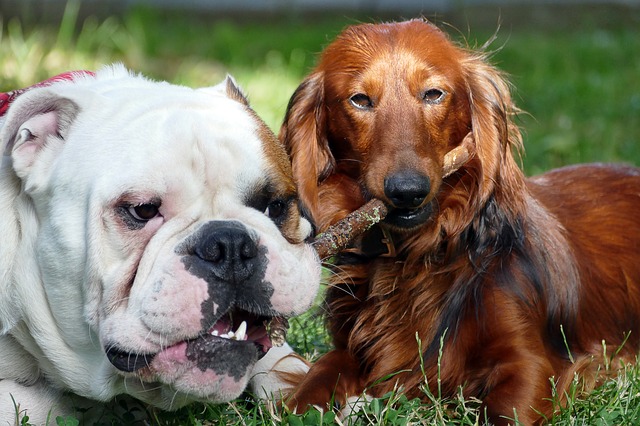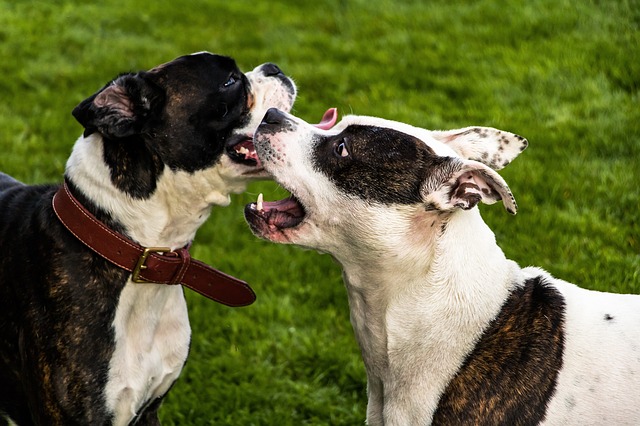When you adopt a new dog into your family, you always have the ability to have your current pooch meet the potential newcomer to make sure they can be compatible co-canines. But what happens when two people move in together — whether as roommates or a couple — and their pups simply don’t get along?
It can be a heartbreaking situation: both parties (understandably) unwilling to surrender their furry friends, or worse, one caving and giving their innocent dog up. This difficult situation can cause a wedge in the relationship, or worse, result in another homeless pet in the world.
If you are struggling to peacefully dwell in a “blended” household with multiple mutts, don’t make any drastic decisions just yet. Try out the techniques below.

Proper introductions
If the dogs in question haven’t met yet, you have the perfect chance to set up a peaceful introduction. Have them meet on neutral territory so neither feels protective, and make sure you bring some treats in order to reward good behavior! Pay attention to each dog in the party and encourage play — but know when it’s getting to rowdy. For more information on helping dogs form a friendly dog, check out this article.
Learn the triggers
But what if it’s too late for first impressions and the introductions have already been made?
Although it may be counter-intuitive, according to Psychology Today, female dogs are more involved in canine conflicts than males.
The good news is, common triggers can be controlled if you stay cognizant and establish a routine. For instance, an owner giving one dog more attention than the other can spark a fight. Another common cause of fighting starts when the two pups get over-excited, like when their owners walk through the door or play time gets too intense. Solutions for these could be putting up a baby gate so there’s a barrier between you and the pups when you come home, or separating your playing pooches when energy begins to escalate. There’s also the possibility of food aggression or resource guarding issues, and although feeding dogs in separate areas can help (more below), the best way to handle any truly aggressive behavior is by enlisting the help of a professional trainer.
The point is, once you know what triggers lead to conflict between your canines, you can put a plan in place and may even be able to prevent it in the first place.

Learn the signs
You should also be able to recognize signs that an altercation is about to break out. Look for signs of aggression in their body language, which may include:
- Growling
- Lip licking
- Snapping
- Lunging
- Crouching
- Fearful or submissive postures
- Tail tucking
If one or both dogs start to display this type of behavior, try distracting them or channeling their energy into something positive (say, a training session with treats) in order to stop things from getting physical.
Know how to break up a fight
Of course, it’s important to be prepared for altercations, and this is good information that every dog parent should know! Your first method of defense when breaking up a dog fight is to stay calm. Yelling and frantically trying to get between two dueling dogs will not only add to the tension and chaos, it could get you seriously injured.
If you need to physically separate dogs, and there’s another person around, each of you can pick up each dog under the rear hips to pull them away from each other. You could also try putting a pillow between the two pups, tossing a blanket over them, spraying them with a water bottle, or simply distracting them with a loud boise. For more in-depth info on safely breaking up dog fights, click here.

Positive conditioning
If one of your dogs is typically the instigator, it is helpful for him to learn to associate the other dog with positive things. Dogington Post explains a method in which the aggressor is kept at a distance from his sibling (who should also be leashed to prevent interaction), and given treats at the sight of the other dog. As you move closer with the instigating pup, keep giving him high-value treats. If he begins behaving aggressively, back up. The goal is for your pooch to eventually associate the site of his sibling with his favorite goodies. To read about this in more detail, click here.
Help them find common ground
Positively reinforce their calm and peaceful interactions with lots of praise and high-value treats. Also, try to include both dogs in activities that they both enjoy but won’t instigate an altercation, such as a car ride. (A game of fetch would not be a good idea since it could promote competition or resource guarding.) If possible, walk with both pups works, too:
“It’s also very important to walk your dogs together, side-by-side. Not only does the exercise help to lower their energy, and hence the impulse to fight, but by moving your dogs forward together it focuses them on a common goal instead of each other,” explains Caesar’s Way.
Establish a routine
Dogs feel more comfortable and secure in a routine, and it could lessen the stress of dogs who are already on edge. For instance, if resource-guarding dogs can benefit from eating their food in their designated spaces around the house, perhaps even at different times. Teach dogs to sit before getting any types of treats or attention, which can prevent squabbles over dropped food; or keep them out of the dining room at dinner time, altogether. Daily exercise is imperative for relieving stress and burning energy, both of which can contribute to fights.
